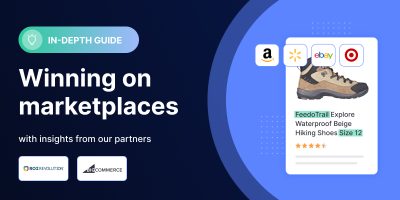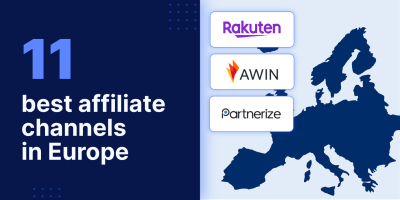Affiliate marketing is one of the best ways for brands to drive web traffic to their products, and its popularity is still increasing. The affiliate marketing market is projected to have a nearly 8% compound annual growth rate through 2030, and the reasons are compelling.
Affiliate marketing uses a commission-based structure, so brands can benefit from low initial investments with high returns. Additionally, social commerce continues to boom, so more businesses are working with influencers to increase exposure to new customers. And thanks to pre-established affiliate marketing networks, the barrier to entry is lower than ever.
To help you develop a winning affiliate marketing strategy, we gathered insights from experts at Revel Interactive, BigCommerce, and Feedonomics about marketing, branding, and product feed management.
This blog is part of a series aimed at helping ecommerce companies win across key shopping destinations:
How to win with affiliate marketing
In a nutshell, this is how affiliate marketing works: a company enlists the services of a third party to promote its products to established audiences in exchange for a commission. Commissions can be based on sales, site visits, signups, a flat revenue percentage, or other actions.
Brands can choose to work with affiliate networks—such as Rakuten, Awin, Partnerize, and others—that offer platforms to help connect them with affiliates (aka publishers) and manage their marketing programs. It’s also possible to manage your own affiliate program, but it requires a very hands-on approach.

Here are some common affiliate models:
- a network of websites displaying ads
- social media influencers who promote products
- review blogs that link to your products
- coupon and cashback sites that reward users for purchases
“If the marketing budget allows for affiliate marketing, start right away. Build your brand's presence across search engine result pages by using highly respected partners to promote your product.”
Choosing an affiliate model for your brand
As always, it’s important to be intentional about any new strategy or opportunity you adopt for your brand. You can either tap into an existing affiliate network or manage your own affiliate program; both options have their benefits.
The benefits of affiliate networks include access to a wide pool of affiliates, more tools for analytics and performance tracking, scalability, fraud detection tools, and less administrative work with regard to payments and relationship management.
“Working with an affiliate network allows you to extend your reach by using multiple sub-partners, while only having to manage one.”
The benefits of a self-managed affiliate program include more selectivity about affiliates, more control over commission structures, no middleman fees to an affiliate platform, closer communication with partners, and self-tailored reporting.
Whether you’re managing your own program or tapping into an existing network, you have options for the types of affiliate marketing you want to employ. Remember to consider the entire customer journey and set goals accordingly for your marketing efforts.
“When working with specific product verticals, it is important to consider the length of decision for a purchase (e.g., a large piece of furniture versus a beauty item) and whether the affiliate channel will be the ‘introducer’ or the ‘closer.’”
Paid ad networks
If you’ve ever looked up a recipe online, you may have noticed the ads displayed in the margins of the page. Often these ads are powered by affiliate programs.
Brands can increase their reach across a variety of ad surfaces and target users based on their interests. That’s why we see ads for ecommerce even though we’re searching for “chicken alfredo recipe at my desk.” It’s also possible to advertise cookware and similar products on relevant pages.

Social media influencers
Influencer marketing is booming with the growth of social commerce. From 2019 to 2024, the global influencer market tripled.
Working with influencers is attractive because they have established, niche audiences. For example, a fashion influencer is going to attract people who want style tips and outfit ideas, so apparel brands would benefit from working with the influencer, assuming that the brand fits the aesthetic.
Blogs with affiliate links
Blogs can provide a thoughtful and long-lasting endorsement of your brand’s products. Like influencers, blogs can have established credibility among audiences with specific interests.
Affiliate links use tracking parameters to identify traffic sources and ultimately give affiliates credit for a purchase or action. For example, a baby product review site might make a list of the five best strollers on the market and include a referral link to your product.
Loyalty programs
Loyalty affiliates are sites or apps that incentivize users to make purchases (or complete any desired action) by offering discounts, points, and other awards. Users frequent these sites with the understanding that they will find the best deals there.
Although you might question the value of incentivizing customers who are going to convert anyway, our experts say there is evidence that cashback programs are effective.
“Several studies have shown that shoppers consider rewards when comparison shopping, and being reminded of cashback offers or coupons in browser extensions before checkout increases their likelihood of converting.”
Managing your affiliate marketing strategy
Part of affiliate marketing’s appeal is the option for a relatively low ongoing cost. A traditional affiliate model allows a business to only pay for performance, which means you don’t take on too much risk.
However, it can be a good idea to also target the top of the funnel, especially in today’s omnichannel environment where every touchpoint can make an impact on your business.
“You can use paid placement campaigns to drive engagement and establish market recognition for your brand with publisher audiences, so your product is top of mind as prospects make their way down the funnel. Increased brand awareness can also lead to more site traffic via SEO.”
It’s also important to be aware of the potential for fraud with affiliate marketing. Unfortunately, fraud accounted for more than 15% of affiliate traffic as recently as 2022. Fraudsters have been known to generate false clicks with bots, set up fake domains, create unauthorized coupon codes, and even bid on brand terms to siphon traffic to their own sites first.
Experienced marketers know how to identify signs of fraud. One good tip is to pay attention to affiliates who generate traffic but have significantly lower sales conversion rates than the rest of the field. And there’s no harm in playing it overly safe if anything feels odd.
“Employ strict partner terms and ensure you can reverse any payments that seem suspicious. Avoid partners who are unresponsive and don’t allow you to see sub-partner lists. If you assume fraud is happening, don’t be afraid to immediately remove the partner. Managing fraud is more important than potential revenue.”
Good project management can keep your affiliate campaigns on track. Each affiliate program should have measurable KPIs and goals, and stay flexible as trends change.
Managing your product data
Affiliate marketing is one piece of a broader ecommerce strategy that can include shopping ads on search channels, email and SMS marketing, direct-to-consumer sales on marketplaces, and shoppable posts on social networks.
Like any ecommerce venture, affiliate marketing requires optimized product data to maximize potential returns. Product feeds are used by affiliate ad networks to ensure that customers are seeing accurate data and reaching the right listings on your site.
Most affiliate marketing platforms accept product feeds that follow Google’s schema, with some additional fields available depending on the platform. The ability to transform your data for different shopping destinations is crucial for getting the most out of your strategies.
For tips on optimizing your product data for ads, check out our guide to winning on search with PLAs.
The specialists at Feedonomics shared a few additional tips for affiliate network product feeds:
- Rakuten: Accepts Google’s format, with additional requirements to include the merchant ID in headers and footers.
- Partnerize: Accepts Google’s format.
- Awin: Accepts Google’s format, with the option to add additional fields based on product types and how the feed will be leveraged. [keywords] and [promotional_text] are commonly used additional fields.
- Impact: Accepts Google’s format, with the option to leverage additional fields like [labels] that can be used to organize your ads by criteria you or your partners find helpful. [bullets] also allows you to add a short list of descriptions about a product, separated by commas.
- AvantLink: Uses Google Product Category taxonomy, with additional fields to organize product types—such as [Department] and [Subcategory]—which can be leveraged to apply Item Based Commission rules.
- CJAffiliate: Accepts Google’s format.
To ensure your partners have the best chance of sending customers your way, you need to make sure your product data is accurate and frequently updated. You should also be testing improvements to your data to see if adjusting your titles, descriptions, images, and other details have an impact on performance.
A feed management platform can make it easy to move and improve data at scale, while ensuring that affiliates have the latest inventory, prices, and product details they need to be effective. A solution like Feedonomics also includes ongoing support and consultation from feed management specialists, so you can focus your time and resources on other business initiatives.
Feedonomics can help you win on affiliate channels.

Mario is a senior content marketing manager based in Texas. He enjoys solving problems, learning about new ecommerce tech, and breaking down complex topics into useful tips for readers.







